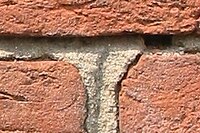
Photo from wikipedia
There are several influencing factors in the preparation of MK (metakaolin)-GGBS (ground granulated blast furnace slag)-based geopolymer repair mortars, including the MK-GGBS ratio, the alkalinity of the alkali activator solution,… Click to show full abstract
There are several influencing factors in the preparation of MK (metakaolin)-GGBS (ground granulated blast furnace slag)-based geopolymer repair mortars, including the MK-GGBS ratio, the alkalinity of the alkali activator solution, the modulus of the alkali activator solution, and the water-to-solid ratio. There are interactions between these factors, such as the different alkaline and modulus requirements of MK and GGBS, the interaction between the alkaline and modulus of the alkali activator solution, and the influence of water throughout the process. The effect of these interactions on the geopolymer repair mortar is not fully understood, making optimization of the MK-GGBS repair mortar ratio difficult. Therefore, in this paper, the response surface methodology (RSM) was used to optimize the preparation of the repair mortar, with GGBS content, SiO2/Na2O molar ratio, Na2O/binder ratio, and water/binder ratio as influencing factors and 1 d compressive strength, 1 d flexural strength, and 1 d bond strength as evaluation indices. Additionally, the repair mortar’s overall performance was assessed in terms of setting time, long-term compressive and bond strength, shrinkage, water absorption, and efflorescence. The results show that RSM was successful in establishing a relationship between the repair mortar’s properties and the factors. The recommended values of the GGBS content, Na2O/binder ratio, SiO2/Na2O molar ratio, and water/binder ratio are 60%, 10.1%, 1.19, and 0.41, respectively. The optimized mortar meets the standard’s requirements for set time, water absorption, shrinkage values, and mechanical strength, with minimal visual efflorescence. The back-scattered electron (BSE) images and energy dispersive spectroscopy (EDS) analysis show that the geopolymer and cement have good interfacial adhesion, and a denser interfacial transition zone exists in the optimized proportion.
Journal Title: Materials
Year Published: 2023
Link to full text (if available)
Share on Social Media: Sign Up to like & get
recommendations!